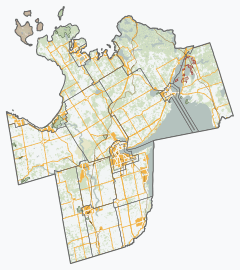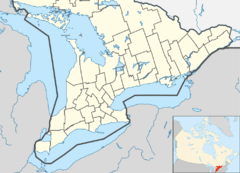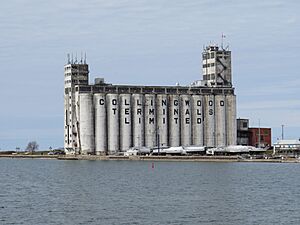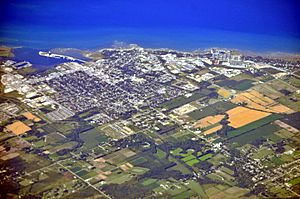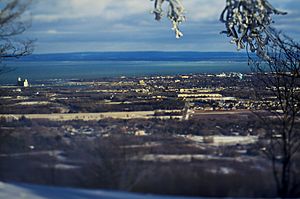Collingwood, Ontario facts for kids
Quick facts for kids
Collingwood
|
||
|---|---|---|
| Town of Collingwood | ||
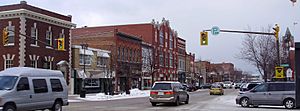
Downtown Collingwood
|
||
|
||
| Nicknames:
"C-wood", "The Wood"
|
||
| Country | ||
| Province | ||
| County | Simcoe | |
| Incorporated | 1858 | |
| Area | ||
| • Land | 33.15 km2 (12.80 sq mi) | |
| Population
(2021)
|
||
| • Total | 24,811 | |
| • Density | 748.3/km2 (1,938/sq mi) | |
| Demonym(s) | Collingwoodite | |
| Time zone | UTC-5 (Eastern (EST)) | |
| • Summer (DST) | UTC-4 (EDT) | |
| Forward sortation area |
L9Y
|
|
| Area code(s) | 705 & 249 | |
| Highways | Former |
|
| Website | www.collingwood.ca | |
Collingwood is a town in Simcoe County, Ontario, Canada. It sits on Nottawasaga Bay, which is part of Georgian Bay. Collingwood is a popular place for tourists. People come here for skiing in winter and to explore limestone caves in summer. These caves are found along the Niagara Escarpment.
Contents
History of Collingwood
The first people to live in this area were the Iroquoian-speaking Petun nation. They built many villages near the Niagara Escarpment. The Iroquois drove them out in 1650. Later, white settlers and freed Black slaves arrived in the 1840s.
Collingwood became a town in 1858. This was nine years before Canada became a country. The town was named after Admiral Cuthbert Collingwood. He was Lord Nelson's second-in-command at the Battle of Trafalgar.
The area had other names too, like Hurontario. This name came from Hurontario Street, which runs from Lake Huron to Lake Ontario. Georgian Bay is part of Lake Huron.
In 1855, the Northern Railway reached Collingwood. This made the harbour a key place for shipping goods. Products were sent to ports like Chicago and Thunder Bay. Grain was a very important product. A huge grain elevator was built in 1929 to help move grain from trains to ships. It operated for 64 years and is still standing today.
Shipping also created a need for ship repairs. So, a shipbuilding business started in Collingwood. On May 24, 1883, the Collingwood Shipyards opened. On September 12, 1901, the Huronic was launched here. It was the first steel-hulled ship in Canada. The shipyards built many lake freighters. During World War II, they even built corvettes for the Royal Canadian Navy. Shipbuilding was a major industry in Collingwood. It employed about 10% of the town's workers. However, due to competition, shipbuilding ended in Collingwood in 1986.
After shipbuilding closed, Collingwood worked to attract new businesses. By 1971, eleven new manufacturing companies had moved to the town. By 1983, eight more companies joined them. This made Collingwood the biggest industrial employer in the region.
Collingwood's Economy
Collingwood has several important industries. Some of the largest employers include Pilkington Glass of Canada and Goodall Rubber Company. However, some industries have closed over the years. These include Nacan Products and Blue Mountain Pottery.
Collingwood is also home to the distillery where Canadian Mist Whisky is made. In 2007, Collingwood Ethanol (now Amaizeingly Green) started making ethanol. This plant produced ethanol for gasoline. It also made organic corn gluten fertilizer. The plant closed in 2012 because corn became too expensive.
Collingwood is a big recreation area because of its location. It is on the southern shores of Georgian Bay. It is also close to Blue Mountain, which is part of the Niagara Escarpment. Blue Mountain is famous for skiing and its Scenic Caves. The town is also near Wasaga Beach Provincial Park. This park became a Biosphere Reserve in 2004.
Local news in Collingwood includes the CollingwoodToday.ca News site. There is also the Collingwood-Wasaga Connection community newspaper. The town has a radio station called CKCB-FM.
Climate in Collingwood
Collingwood has a humid continental climate. This means it gets a good amount of both snow and rain throughout the year.
In spring, the weather slowly gets warmer. This is because of the nearby Georgian Bay. There are often showers, which can turn into strong storms later in the season. Temperatures usually range from -5°C to 22°C (23°F to 72°F).
Summer brings warm and humid conditions. Lake breezes often help to cool things down. Thunderstorms happen regularly in summer. Sometimes, these storms can even cause tornadoes. Temperatures can range from 11°C to 26°C (52°F to 79°F). The humidity can make it feel much hotter.
Fall usually arrives later in Collingwood than in other parts of Canada. This is because of the warm waters of Georgian Bay. Strong storms, sometimes called "November witches," can bring days of strong winds, rain, and snow. Lake effect snow also starts around this time. Temperatures typically range from -10°C to 20°C (14°F to 68°F).
Winter is often cloudy, cool, and wet. There are frequent winds and frosts. Sometimes, the weather warms up for a few days, melting some of the snow. Lake effect snow lasts most of the winter. It causes a lot of snow to fall in the region. Winter temperatures usually range from -20°C to 5°C (-4°F to 41°F).
Collingwood's Neighbourhoods
Collingwood Heritage Conservation District
The Collingwood Heritage Conservation District is a special area. It was officially recognized in 2002. Collingwood was the first town in Canada to have a Heritage Conservation District added to the national register.
This area is around the town's downtown. It includes 260 properties and important landmarks. These include the Shipyards redevelopment and the Collingwood Terminals grain elevator. The town hall is also in this district.
Creative Simcoe Street
A part of Simcoe Street is known as Creative Simcoe Street. This area is inside the Heritage Conservation District. It is home to many artist studios, art galleries, and restaurants.
You can also find the Collingwood Museum and Public Library here. The historic Tremont House building is on this street. The Simcoe Street Theatre is also located here. It is managed by the town's Parks, Recreation, and Culture Department.
This two-block stretch of Simcoe Street connects to the main street, Hurontario Street. It ends at St. Paul Street. The name "Creative Simcoe Street" is used by local media and businesses. However, it is not an official neighbourhood name.
Transportation
Collingwood is served by Highway 26. This highway runs along the shore of Nottawasaga Bay. County Road 124 also serves the town.
There is a rail trail in Collingwood. This trail follows the path of an old railway line. It connects Collingwood to Owen Sound and Barrie. A branch of the trail goes to the large grain elevators at the downtown wharf. Trains used to load and unload goods onto ships there.
Colltrans is Collingwood's local public transit system. Simcoe County LINX is a regional transit service. It connects Collingwood to other cities like Barrie. From Barrie, you can connect to other services like GO Transit.
Collingwood also has an airport. The Collingwood Airport (CNY3) is about 4 km (2.5 miles) south of the town.
Notable people
Athletes
NHL Hockey Players
- Jason Arnott, forward
- Claire Alexander, defenceman
- Bernie Brophy, forward
- Roy Burmister, forward
- Eddie Bush, defenceman and coach
- Kevin Colley, forward
- Jimmy Herbert, player
- Ed Kea, player
- Lindsay Middlebrook, goaltender
- Reg Noble, forward
- Randy Osburn, forward
- Jack Portland, defenceman
- Paul Shakes, defenceman
- Darryl Sly, defenceman
Olympians
- Megan Lane, equestrian
- Herbert McDonald, cyclist
- Sue Palmer-Komar, cyclist
- Roni Remme, alpine ski racer
- Robert H. Storey, bobsleigh
- Brian Saunderson, former Olympic rower
Other Athletes
- Amanda Sin, Pan Am Games bronze medallist in mountain biking
- Zach Stone, snowboarder
- Burke Dales, CFL punter
- Stacey Dales, WNBA player and NFL Network reporter
- Morey Doner, soccer player
Miscellaneous Notable People
- Andrea Canning, Dateline NBC host
- Jesse Thomas Cook, filmmaker
- Edna Jaques (1891–1978), poet
- Norah M. Holland (1876–1925), writer
Demographics
| Historical populations | ||
|---|---|---|
| Year | Pop. | ±% |
| 1871 | 2,829 | — |
| 1881 | 4,445 | +57.1% |
| 1891 | 4,939 | +11.1% |
| 1901 | 5,755 | +16.5% |
| 1911 | 7,090 | +23.2% |
| 1921 | 5,882 | −17.0% |
| 1931 | 5,809 | −1.2% |
| 1941 | 6,249 | +7.6% |
| 1951 | 7,413 | +18.6% |
| 1961 | 8,385 | +13.1% |
| 1971 | 9,775 | +16.6% |
| 1981 | 12,064 | +23.4% |
| 1991 | 13,505 | +11.9% |
| 1996 | 15,596 | +15.5% |
| 2001 | 16,039 | +2.8% |
| 2006 | 17,290 | +7.8% |
| 2011 | 19,241 | +11.3% |
| 2016 | 21,793 | +13.3% |
| 2021 | 24,811 | +13.8% |
In the 2021 Census, Collingwood had a population of 24,811 people. This was a 13.8% increase from its 2016 population of 21,793. The town has a land area of 33.15 square kilometers. This means there were about 748 people living in each square kilometer in 2021.
| Canada census – Collingwood community profile | |||
|---|---|---|---|
| 2016 | 2011 | 2006 | |
| Population: | 21,973 (+13.3% from 2011) | 19,241 (+11.3% from 2006) | 17,503 (+7.8% from 2001) |
| Land area: | 33.78 km2 (13.04 sq mi) | 33.46 km2 (12.92 sq mi) | 33.46 km2 (12.92 sq mi) |
| Population density: | 645.1/km2 (1,671/sq mi) | 575.1/km2 (1,490/sq mi) | 516.8/km2 (1,339/sq mi) |
| Median age: | 49.2 (M: 46.6, F: 51.3) | 44.4 (M: 42.3, F: 46.0) | |
| Total private dwellings: | 11,617 | 10,695 | 9448 |
| Median household income: | $64,369 | $48,839 | |
| Notes: Includes corrections and updates. – References: 2016 2011 2006 earlier | |||
Recreation and Sports
Collingwood is a great place for outdoor fun all year round. In winter, people enjoy snowshoeing, cross-country skiing, snowboarding, and downhill skiing. In summer, popular activities include swimming, hiking, and biking.
There are many trails for these activities. One famous trail is the Georgian Trail, which connects to the Bruce Trail.
Hockey has a long history in Collingwood. The first hockey rink was built in 1883. The first official hockey game was played in 1894 against a team from Barrie. Collingwood joined a Simcoe County league in 1894. It also got a team in the new Ontario Hockey Association in 1895.
The Park Street Arena, now the Collingwood Curling Club, was built in 1909. The arena now known as Eddie Bush Memorial was built in 1948. Collingwood has even hosted training sessions for Team Canada, the Toronto Maple Leafs, and Montreal Canadiens.
Sister Cities
Collingwood has special partnerships with cities around the world. These are called "sister cities."
- Boone, North Carolina, United States
- Zihuatanejo, Mexico
- Katano, Japan
See also
 In Spanish: Collingwood (Ontario) para niños
In Spanish: Collingwood (Ontario) para niños



